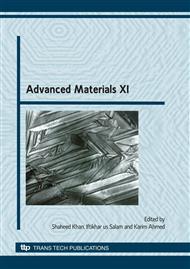p.88
p.96
p.102
p.109
p.116
p.123
p.130
p.137
p.144
Synthesis of Multiwall Carbon Nanotube and their Thin Films for Infrared Sensor Applications
Abstract:
Catalytic synthesis of carbon multiwall nanotubes (MWCNT) was carried out by chemical vapor deposition. Synthesis temperature was 750oC, whereas, iron nitrate and ethanol was used as catalyst and carbonaceous source, respectively. The carbon nanotubes produced were multiwall and tangled in nature with nominal diameter of 50nm and length 2.5µm. These MWCNTs were purified by an acidic treatment and subsequently functionalized by chemical oxidation. After synthesis and functionalizing, a thin film of MWCNT was deposited on quartz substrates which were coated with copper electrodes. Investigations showed that during film preparation a bridging of CNTs was established between the copper electrodes which were further revealed to be semi-conductive by current Vs voltage testing. The discernable characteristics included batter conduction and infrared photocurrent responses.
Info:
Periodical:
Pages:
116-122
Citation:
Online since:
June 2010
Authors:
Price:
Сopyright:
© 2010 Trans Tech Publications Ltd. All Rights Reserved
Share:
Citation:


